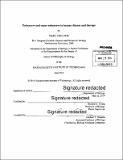| dc.contributor.advisor | Richard A. Young. | en_US |
| dc.contributor.author | Hoke, Heather Ashley | en_US |
| dc.contributor.other | Massachusetts Institute of Technology. Department of Biology. | en_US |
| dc.date.accessioned | 2014-09-19T21:30:05Z | |
| dc.date.available | 2014-09-19T21:30:05Z | |
| dc.date.copyright | 2014 | en_US |
| dc.date.issued | 2014 | en_US |
| dc.identifier.uri | http://hdl.handle.net/1721.1/89942 | |
| dc.description | Thesis: Ph. D., Massachusetts Institute of Technology, Department of Biology, 2014. | en_US |
| dc.description | Cataloged from PDF version of thesis. | en_US |
| dc.description | Includes bibliographical references. | en_US |
| dc.description.abstract | The human body is made up of a diverse array of cell types, each with specialized properties and functions that support the organism as a whole. Despite this variability, with few exceptions, these cells contain the same genetic information. The incredible diversity in cellular function arises from differences in gene expression between cell types. Regulation of gene expression involves complex interactions between transcription factors and cofactors and the transcriptional machinery. These interactions occur both at the core promoter and at distal regulatory regions, enhancers, which are looped into close physical proximity with the core promoter. Enhancer regions are typically utilized in a cell-type-specific manner and help to drive the distinct gene expression programs that define diverse cell identities. New technologies have allowed greater ability to map enhancer regions in a variety of cell types in both healthy and diseased tissue. It is becoming increasingly apparent that mis-regulation of enhancer regions is a major component of many human diseases, including cancer. In addition, the availability of new classes of small molecule inhibitors targeting enhancer-bound transcriptional cofactors suggests that disruption of enhancer function may be an important therapeutic strategy in disease. Identification of super-enhancers, clusters of enhancer regions that are occupied by exceptional levels of many transcriptional co-activators, may further inform our understanding of human development and disease. These super-enhancers are associated with genes that control and define cell state, including many important disease-associated factors. In addition, super-enhancers are particularly vulnerable to perturbation by small molecules targeting enhancer-associated factors. This suggests that super-enhancers may be both biomarkers for disease-critical genes, and Achilles heels, allowing these genes to be targeted by small molecule therapies. | en_US |
| dc.description.statementofresponsibility | by Heather Ashley Hoke. | en_US |
| dc.format.extent | 241 pages | en_US |
| dc.language.iso | eng | en_US |
| dc.publisher | Massachusetts Institute of Technology | en_US |
| dc.rights | M.I.T. theses are protected by copyright. They may be viewed from this source for any purpose, but reproduction or distribution in any format is prohibited without written permission. See provided URL for inquiries about permission. | en_US |
| dc.rights.uri | http://dspace.mit.edu/handle/1721.1/7582 | en_US |
| dc.subject | Biology. | en_US |
| dc.title | Enhancers and super-enhancers in human disease and therapy | en_US |
| dc.type | Thesis | en_US |
| dc.description.degree | Ph. D. | en_US |
| dc.contributor.department | Massachusetts Institute of Technology. Department of Biology | |
| dc.identifier.oclc | 890124102 | en_US |
